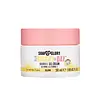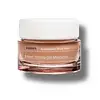What's inside
What's inside
 Key Ingredients
Key Ingredients

 Benefits
Benefits

 Concerns
Concerns

 Ingredients Side-by-side
Ingredients Side-by-side

Water
Skin ConditioningGlycerin
HumectantCaprylic/Capric Triglyceride
MaskingCetearyl Alcohol
EmollientButyrospermum Parkii Butter
Skin ConditioningDimethicone
EmollientPolyacrylamide
Phenoxyethanol
PreservativeSteareth-2
EmulsifyingSteareth-21
CleansingC13-14 Isoparaffin
EmollientChlorphenesin
AntimicrobialAscorbyl Tetraisopalmitate
AntioxidantLaureth-7
Emulsifying3-O-Ethyl Ascorbic Acid
Skin ConditioningBHT
AntioxidantSodium Citrate
BufferingLimonene
PerfumingDipropylene Glycol
HumectantCitric Acid
BufferingPropylene Glycol
HumectantAlcohol Denat.
AntimicrobialParfum
MaskingBenzotriazolyl Dodecyl P-Cresol
UV AbsorberLinalool
PerfumingGlycine Soja Oil
EmollientLecithin
EmollientAlcohol
AntimicrobialTris(Tetramethylhydroxypiperidinol)Citrate
StabilisingCaprylyl Glycol
EmollientXanthan Gum
EmulsifyingPotassium Sorbate
PreservativeUbiquinone
AntioxidantCarrageenan
CI 14700
Cosmetic ColorantCI 15985
Cosmetic ColorantCI 19140
Cosmetic ColorantWater, Glycerin, Caprylic/Capric Triglyceride, Cetearyl Alcohol, Butyrospermum Parkii Butter, Dimethicone, Polyacrylamide, Phenoxyethanol, Steareth-2, Steareth-21, C13-14 Isoparaffin, Chlorphenesin, Ascorbyl Tetraisopalmitate, Laureth-7, 3-O-Ethyl Ascorbic Acid, BHT, Sodium Citrate, Limonene, Dipropylene Glycol, Citric Acid, Propylene Glycol, Alcohol Denat., Parfum, Benzotriazolyl Dodecyl P-Cresol, Linalool, Glycine Soja Oil, Lecithin, Alcohol, Tris(Tetramethylhydroxypiperidinol)Citrate, Caprylyl Glycol, Xanthan Gum, Potassium Sorbate, Ubiquinone, Carrageenan, CI 14700, CI 15985, CI 19140
Water
Skin ConditioningGlycerin
HumectantPropanediol
SolventCaprylic/Capric/Myristic/Stearic Triglyceride
EmollientCoco-Caprylate
EmollientImperata Cylindrica Root Extract
Skin ConditioningSodium Acrylates Copolymer
C13-15 Alkane
SolventHydrogenated Ethylhexyl Olivate
EmollientAcrylates/C10-30 Alkyl Acrylate Crosspolymer
Emulsion StabilisingAlgin
MaskingAscorbyl Palmitate
AntioxidantAscorbyl Tetraisopalmitate
AntioxidantBehenyl Alcohol
EmollientCaprylyl Glycol
EmollientCarbomer
Emulsion StabilisingCellulose Gum
Emulsion StabilisingCetearyl Alcohol
EmollientChamomilla Recutita Flower Extract
MaskingCitric Acid
BufferingDictyopteris Polypodioides Extract
EmollientDisodium Phosphate
BufferingGlyceryl Acrylate/Acrylic Acid Copolymer
HumectantGlyceryl Caprylate
EmollientGlyceryl Polyacrylate
Glyceryl Stearate Citrate
EmollientHelianthus Annuus Seed Oil
EmollientHydrogenated Olive Oil Unsaponifiables
EmollientHydrolyzed Sodium Hyaluronate
Skin ConditioningLactic Acid
BufferingLecithin
EmollientLevulinic Acid
PerfumingMica
Cosmetic ColorantMicrocrystalline Cellulose
AbsorbentPancratium Maritimum Extract
BleachingPanthenol
Skin ConditioningPentylene Glycol
Skin ConditioningPolyacrylate Crosspolymer-6
Emulsion StabilisingPotassium Phosphate
BufferingPullulan
Rosa Canina Fruit Extract
AstringentRosa Canina Fruit Oil
EmollientRosmarinus Officinalis Extract
AntimicrobialSerine
MaskingSodium Hyaluronate
HumectantSodium Levulinate
Skin ConditioningSqualane
EmollientSynthetic Fluorphlogopite
Terminalia Ferdinandiana Fruit Extract
AntioxidantTetrasodium Glutamate Diacetate
Tin Oxide
AbrasiveTocopherol
AntioxidantTocopheryl Acetate
AntioxidantTrehalose
HumectantUrea
BufferingXanthan Gum
EmulsifyingCI 77491
Cosmetic ColorantCI 77499
Cosmetic ColorantCI 77891
Cosmetic ColorantBenzyl Alcohol
PerfumingPhenoxyethanol
PreservativeSodium Benzoate
MaskingParfum
MaskingAlcohol Denat.
AntimicrobialWater, Glycerin, Propanediol, Caprylic/Capric/Myristic/Stearic Triglyceride, Coco-Caprylate, Imperata Cylindrica Root Extract, Sodium Acrylates Copolymer, C13-15 Alkane, Hydrogenated Ethylhexyl Olivate, Acrylates/C10-30 Alkyl Acrylate Crosspolymer, Algin, Ascorbyl Palmitate, Ascorbyl Tetraisopalmitate, Behenyl Alcohol, Caprylyl Glycol, Carbomer, Cellulose Gum, Cetearyl Alcohol, Chamomilla Recutita Flower Extract, Citric Acid, Dictyopteris Polypodioides Extract, Disodium Phosphate, Glyceryl Acrylate/Acrylic Acid Copolymer, Glyceryl Caprylate, Glyceryl Polyacrylate, Glyceryl Stearate Citrate, Helianthus Annuus Seed Oil, Hydrogenated Olive Oil Unsaponifiables, Hydrolyzed Sodium Hyaluronate, Lactic Acid, Lecithin, Levulinic Acid, Mica, Microcrystalline Cellulose, Pancratium Maritimum Extract, Panthenol, Pentylene Glycol, Polyacrylate Crosspolymer-6, Potassium Phosphate, Pullulan, Rosa Canina Fruit Extract, Rosa Canina Fruit Oil, Rosmarinus Officinalis Extract, Serine, Sodium Hyaluronate, Sodium Levulinate, Squalane, Synthetic Fluorphlogopite, Terminalia Ferdinandiana Fruit Extract, Tetrasodium Glutamate Diacetate, Tin Oxide, Tocopherol, Tocopheryl Acetate, Trehalose, Urea, Xanthan Gum, CI 77491, CI 77499, CI 77891, Benzyl Alcohol, Phenoxyethanol, Sodium Benzoate, Parfum, Alcohol Denat.
Ingredients Explained
These ingredients are found in both products.
Ingredients higher up in an ingredient list are typically present in a larger amount.
Alcohol Denat. is an alcohol with a denaturant property. It is created by mixing ethanol with other additives.
This ingredient gets a bad rep because it is irritating and drying - mostly due to its astringent property. Astringents draw out natural oils in tissue, constricting pores and leaving your skin dried out.
However, alcohol denat. is not all that bad.
Due to its low molecular weight, alcohol denat. tends to evaporate quickly. One study on pig skin found half of applied alcohol evaporated in 10 seconds and less than 3% stayed on skin.
This also helps other ingredients become better absorbed upon application.
Studies are conflicted about whether this ingredient causes skin dehydration. One study from 2005 found adding emollients to propanol-based sanitizer decreased skin dryness and irritation. Another study found irritation only occurs if your skin is already damaged.
Small amounts of alcohol are generally tolerated by oily skin or people who live in humid environments.
The rule of thumb is if this alcohol is near the end of an ingredients list, it will probably not affect your skin much.
Also...
This ingredient has antimicrobial and solvent properties.
The antimicrobial property helps preserve products and increase their shelf life. As a solvent, it helps dissolve other ingredients.
Other types of astringent alcohols include:
Learn more about Alcohol Denat.Ascorbyl Tetraisopalmitate is a version of ascorbic acid, or Vitamin C.
This ingredient has many benefits including reducing wrinkles, skin soothing, dark spot fading, and fighting against free radicals.
It helps with dark spot fading by interfering with the process of skin darkening, helping to reduce hyperpigmentation. Like other forms of vitamin C, this ingredient encourages the skin to create more collagen.
As an antioxidant, it helps fight free-radicals. Free-radicals are molecules that may damage your skin cells.
One study found Ascorbyl Tetraisopalmitate to degrade in sunlight, but is stabilized when combined with acetyl zingerone.
Learn more about Ascorbyl TetraisopalmitateCaprylyl Glycol is a humectant and emollient, meaning it attracts and preserves moisture.
It is a common ingredient in many products, especially those designed to hydrate skin. The primary benefits are retaining moisture, skin softening, and promoting a healthy skin barrier.
Though Caprylyl Glycol is an alcohol derived from fatty acids, it is not the kind that can dry out skin.
This ingredient is also used as a preservative to extend the life of products. It has slight antimicrobial properties.
Learn more about Caprylyl GlycolCetearyl alcohol is a mixture of two fatty alcohols: cetyl alcohol and stearyl alcohol. It is mainly used as an emulsifier. Emulsifiers help prevent the separation of oils and products. Due to its composition, it can also be used to thicken a product or help create foam.
Cetearyl alcohol is an emollient. Emollients help soothe and hydrate the skin by trapping moisture.
Studies show Cetearyl alcohol is non-toxic and non-irritating. The FDA allows products labeled "alcohol-free" to have fatty alcohols.
This ingredient is usually derived from plant oils such as palm, vegetable, or coconut oils. There is debate on whether this ingredient will cause acne.
Due to the fatty acid base, this ingredient may not be Malassezia folliculitis safe.
Learn more about Cetearyl AlcoholCitric Acid is an alpha hydroxy acid (AHA) naturally found in citrus fruits like oranges, lemons, and limes.
Like other AHAs, citric acid can exfoliate skin by breaking down the bonds that hold dead skin cells together. This helps reveal smoother and brighter skin underneath.
However, this exfoliating effect only happens at high concentrations (20%) which can be hard to find in cosmetic products.
Due to this, citric acid is usually included in small amounts as a pH adjuster. This helps keep products slightly more acidic and compatible with skin's natural pH.
In skincare formulas, citric acid can:
While it can provide some skin benefits, research shows lactic acid and glycolic acid are generally more effective and less irritating exfoliants.
Most citric acid used in skincare today is made by fermenting sugars (usually from molasses). This synthetic version is identical to the natural citrus form but easier to stabilize and use in formulations.
Read more about some other popular AHA's here:
Learn more about Citric AcidGlycerin is already naturally found in your skin. It helps moisturize and protect your skin.
A study from 2016 found glycerin to be more effective as a humectant than AHAs and hyaluronic acid.
As a humectant, it helps the skin stay hydrated by pulling moisture to your skin. The low molecular weight of glycerin allows it to pull moisture into the deeper layers of your skin.
Hydrated skin improves your skin barrier; Your skin barrier helps protect against irritants and bacteria.
Glycerin has also been found to have antimicrobial and antiviral properties. Due to these properties, glycerin is often used in wound and burn treatments.
In cosmetics, glycerin is usually derived from plants such as soybean or palm. However, it can also be sourced from animals, such as tallow or animal fat.
This ingredient is organic, colorless, odorless, and non-toxic.
Glycerin is the name for this ingredient in American English. British English uses Glycerol/Glycerine.
Learn more about GlycerinLecithin is a term for a group of substances found in the cell membranes of plants, animals, and humans. They are made up of mixture of phospholipids.
This ingredient has emollient and emulsifying properties.
As an emollient, lecithen helps soften the skin and creates a barrier to keep moisture in.
As an emulsifier, it also helps prevent water and oil ingredients from separating. Lecithin can also help ingredients be better absorbed by the skin.
This is because the phospholipids in lecithin produce liposomes. Liposomes help other ingredients get through the skin barrier.
Depending on the source of this ingredient, lecithin may not be fungal acne safe. This is because some sources of lecithin come from soybean oil, which may feed the malassezia yeast that feeds fungal acne.
We recommend reaching out to the brand you are purchasing from to inquire about the source of their lecithin.
Some other names for this ingredient include soy lecithin and deoiled soy lecithin.
Learn more about LecithinParfum is a catch-all term for an ingredient or more that is used to give a scent to products.
Also called "fragrance", this ingredient can be a blend of hundreds of chemicals or plant oils. This means every product with "fragrance" or "parfum" in the ingredients list is a different mixture.
For instance, Habanolide is a proprietary trade name for a specific aroma chemical. When used as a fragrance ingredient in cosmetics, most aroma chemicals fall under the broad labeling category of “FRAGRANCE” or “PARFUM” according to EU and US regulations.
The term 'parfum' or 'fragrance' is not regulated in many countries. In many cases, it is up to the brand to define this term.
For instance, many brands choose to label themselves as "fragrance-free" because they are not using synthetic fragrances. However, their products may still contain ingredients such as essential oils that are considered a fragrance by INCI standards.
One example is Calendula flower extract. Calendula is an essential oil that still imparts a scent or 'fragrance'.
Depending on the blend, the ingredients in the mixture can cause allergies and sensitivities on the skin. Some ingredients that are known EU allergens include linalool and citronellol.
Parfum can also be used to mask or cover an unpleasant scent.
The bottom line is: not all fragrances/parfum/ingredients are created equally. If you are worried about fragrances, we recommend taking a closer look at an ingredient. And of course, we always recommend speaking with a professional.
Learn more about ParfumPhenoxyethanol is a preservative that has germicide, antimicrobial, and aromatic properties. Studies show that phenoxyethanol can prevent microbial growth. By itself, it has a scent that is similar to that of a rose.
It's often used in formulations along with Caprylyl Glycol to preserve the shelf life of products.
Water. It's the most common cosmetic ingredient of all. You'll usually see it at the top of ingredient lists, meaning that it makes up the largest part of the product.
So why is it so popular? Water most often acts as a solvent - this means that it helps dissolve other ingredients into the formulation.
You'll also recognize water as that liquid we all need to stay alive. If you see this, drink a glass of water. Stay hydrated!
Learn more about WaterXanthan gum is used as a stabilizer and thickener within cosmetic products. It helps give products a sticky, thick feeling - preventing them from being too runny.
On the technical side of things, xanthan gum is a polysaccharide - a combination consisting of multiple sugar molecules bonded together.
Xanthan gum is a pretty common and great ingredient. It is a natural, non-toxic, non-irritating ingredient that is also commonly used in food products.
Learn more about Xanthan Gum